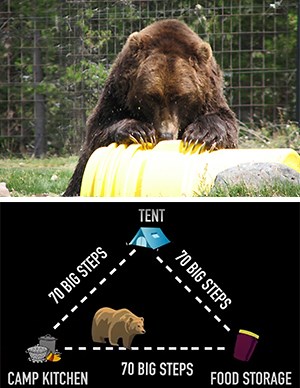
Keep Lassen WildThe majority of Lassen Volcanic National Park is designated Wilderness, a status afforded to just five percent of America’s public lands. You can enjoy and preserve these wild places by not contributing to recreation-related impacts including: litter, erosion, social trail creation, food-conditioned wildlife, and backcountry campsite widening. Please adhere to regulations and practice Leave No Trace (LNT) principles to help preserve natural conditions and minimize human influence. Plan Your Backpacking TripA backpacking trip in Lassen Volcanic National Park can be an exciting and rewarding experience if you are prepared. 1. Choose Your Route and Research Your TripRangers are not able to assist with planning a backcountry trip. We recommend the following steps to help you to select a route that is suitable to your group's interest and abilities. Read the backcountry camping regulations. There are no designated backcountry campsites or trail quotas in the park. Wilderness permits are required for backcountry camping and are only obtained online through Recreation.gov. Wilderness permits are no longer available from the park directly. Looking to camp before or after your backpacking trip? If staying in the park, you must camp within an established park campground before or after your trip. Sleeping in a vehicle or RV in a parking lot or pull-out is not permitted, even with a backcountry permit. (The one exception is the parking lot at the Kohm Yah-mah-nee Visitor Center, where camping in a self-contained vehicle is permitted with a fee of $10/night.)
2. Bring or rent a NPS-approved bear-resistant container.Containers are required from April 16 - November 30. Hanging food is not permitted. 3. Obtain a Wilderness Permit Online.Wilderness permits are only available online through Recreation.gov. Permits are no longer available in person and the park does not mail permits. Permits can be reserved up to a maximum of 90 days prior to the start date. Wilderness Permit RequiredA wilderness permit is required to camp in park's backcountry (outside of park campgrounds). A permit is not required for day hiking and is not required if you are staying in an established park campground. There are no designated backcountry campsites or quotas in the park.
Park entrance fees are separate. Learn more about park entrance fees. How to Obtain a Wilderness Permit
Backpacking TrailheadsThe largest network of trails is located in the eastern half of the park. These trails are accessed via four primary backpacking trailheads: Warner Valley, Butte Lake, Juniper Lake, and Summit Lake.

Bear-Resistant Container RequiredBackcountry campers must use an approved bear-resistant container to store food and scented items. This regulation is in response to increased negative bear and human interactions in the park. Bear canisters are not required December 1 through April 15. Stay with or Store Your FoodBears obtaining improperly stored food has and may again result in park closures. At least one bear obtained food and/or scented items that hikers had not stored in bear-resistant containers in 2020. After multiple incidents, the bear learned to associate humans and their equipment with a food reward. Bear Canister RentalBear-resistant food canisters may be available for rent in limited quantities at park bookstores, located in Kohm Yah-mah-nee Visitor Center and Loomis Plaza. Rental is $10 for 7 days with a $95 deposit for either size canister. Canisters must be returned to the location rented. There will be a $15 charge for canisters returned dirty (not including wear/dirt from normal use). 
Top: Grizzly & Wolf Discovery Center. Bottom: Leave No Trace Center for Outdoor Ethics. How to Use a Bear-Resistant ContainerWhat to Put InsideThe most important part of using a bear-resistant container is what goes inside it. Make sure all food, trash, toiletries, and other scented items are inside the container. This includes but is not limited to all sealed or packaged food, sunscreen, soap, mosquito repellent, lip balm, deodorant, medications, and feminine products. As a general rule, if you put it in your mouth or on your skin, it should probably be stored in a bear-resistant container. Learn how to get the most out of and into your bear canister from sierrawild.gov. Where to Place ItPlace the container on the ground 100 feet (or 70 big steps) from both your tent and cooking area, in a place where a bear can't easily roll it away. Take care not to place it near a cliff or any water source, as a bear may knock the container around or roll it down a hill. Do not hang or attach anything to the container (ropes attached to the container enable a bear to carry it away). Watch How to Use a Bear Canister from Leave No Trace Center for Outdoor Ethics. Keep Canisters Closed and LockedBear-resistant canisters work, but only when they are locked. Be sure to keep it closed and locked any time it's not in use. The Bear Vault canisters available in the park have a special latch that requires human dexterity to open. Your fingernail, a credit card, or other thin, hard tool can be helpful when opening the canister. When closing the canister, make sure to turn the lid until you hear the latch click. We recommend trying to open it by turning it counterclockwise to verify it's locked. Keep in mind that a bear may easily get to your canister, but it cannot get what is inside if it's locked. General QuestionsIf you have questions about backpacking or permits, please email us. Before sending an email, please read this entire webpage, as most of your questions are likely to be answered already. Rangers are able to assist with questions regarding permitting, regulations, closures, conditions (when available), and safety. Rangers are not able to provide route suggestions. |
Last updated: August 29, 2025
